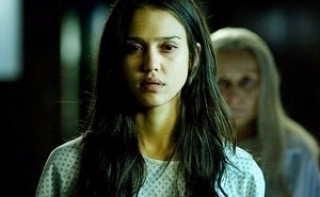(THIS ARTICLE IS MACHINE TRANSLATED by Google from Norwegian)
[film] It is said that there are only seven basic dramaturgical stories, and that all stories are a variation on one of them – possibly a mixture of several. With that in mind, it's no wonder that new recordings are a widespread phenomenon. If someone has first put together a story that works, it is tempting for others to copy it – rather than spending time and effort coming up with something of their own, which may not work as well.
In recent years, Hollywood versions of Asian horror films have been in line. Japanese Ringu (1998) joined The Ring (2002), and in the wake came The Ring 2 (2005), Dark Water (2005), which was based on Honogurai mizu no soko kara (2002), and The Grudge (2004), called Ju-On (2003) in original recording. This year, Chakushin Ari (2003) has become One Missed Call.
25. April The Eye premieres at Norwegian cinemas. This is a remake of the Pang brothers' thematically interesting Gin gwai (2002), of which an Indian version has already been made, entitled Naina (2005). In the original, we meet the blind girl Mun as she undergoes an eye transplant. She gets the gift in sight, but with the purchase comes an uncanny ability: She sees the ghost. The film discusses perception and interpretation of visual impressions quite thoroughly.
Gin gwai is more atmospheric than directly intimidating. Hollywood has tried to do something about it in its adaptation, where Mun is named Sydney and played by Jessica Alba. The Eye has more and more violent shock than the original, and is consistently more aggressive in tone.
Roland Barthes in his time was thinking about whether Europeans and Asians had a fundamentally different understanding of eyeballs. Unlike the Asians, the Europeans take it for granted that it is hiding something behind the eyes, comparing the notions of the eye as the mirror of the soul. In this way, Gin gwai is genuinely Asian. The donor eyes take over the whole sensory apparatus of Mun / Sydney, instead of mirroring her inner life.
However, the climax of The Eye is genuinely Hollywood. While the original ends in tragedy, where a host of ghosts rise from the scene after a major accident, Sydney rescues the living from the disaster in The Eye.
The directors are European. And in our globalized age, it no longer makes sense to talk too categorically about the differences between European and American film. Not when Michael Haneke takes the trip across the pond to create a new version of his own Funny Games (1997). Also a kind of horror movie.
Violence for our sake
Both Funny Games and Gin gwai / The Eye comment on the film medium and the audience's relationship to it. The Eye makes it implicit and relatively subtle. Funny Games makes it explicit and confrontational.
A core family goes to the cottage to enjoy some slow days. There they are approached by two young men, who appear from an increasingly unpleasant side. Sadistic violence is on the agenda. And the audience is involved. The two perpetrators approach us directly, and insist that they do this for our sake. Because we expect it.
Haneke has almost copied the original, with a few deviations. The balance between the spouses has changed. In the original, they played equal roles. In the 2008 version, Naomi Watt's character becomes dominant. Here it may be appropriate to mention that Watts is also a co-producer on the new recording. Another striking difference is that Watts spends a good deal of time in his underwear, as opposed to what Susanne Lothar did in the original.
The biggest difference is probably still that the audience potential is infinitely much greater this time. Thanks to star names like Watts and Tim Roth, as well as English dialogue. And here we may find Haneke's motivation to repeat himself. He sees this as a chance to reach the audience outside the arthouse environment.
The fascination for the details
The classic counter-argument against new recordings is: What's the point? And the almost equally classic answer is: It is in the details that the value lies. A few small changes in thematic treatment and stylistic execution can mean the whole world.
Michael Mann has directed two versions of the same script. The best version by far is known as Heat (1995), while the TV movie LA Takedown (1989) can hardly be said to be an equally good film. Only details separate the two. In 1998, Gus Van Sant recorded a new version of Alfred Hitchcock's superclassic Psycho. Van Sant meticulously copied the master's film frame by frame. The only thing he added was a masturbation scene where Norman Bates (Vince Vaughn) peeks at Marion Crane (Anne Heche). Hitchcock's film still stands as a pillar in film history. Van Sant's cover version is considered a slightly embarrassing episode in the director's career.
Horror film is a genre where the new recordings come close. Probably because it is a genre with great youth appeal, so that one can frequently recycle old horrors to new cohorts. Lately, we have been able to shudder at new versions of the Texas Chainsaw Massacre, The Hills Have Eyes and The Hitcher.
The Asian wave of new versions in Hollywood, on the other hand, seems to be coming to an end, unless The Eye should be a huge success. The new recordings make less and less money. While The Ring garnered nearly $ 250 million worldwide, The Grudge 2 (2006) ended up at $ 69 million, and One Missed Call failed to break the $ 30 million mark.
But Hollywood is guaranteed to find new candidates. Both in horror films and other genres. The benefits of planking an already fully developed film concept are too many to give up. And some new basic stories are unlikely to emerge.


